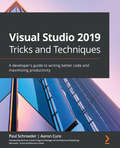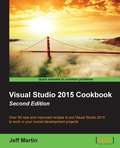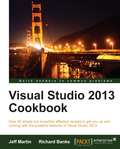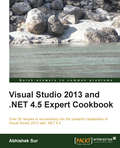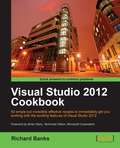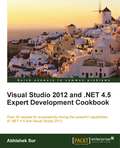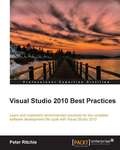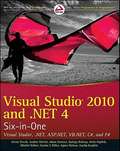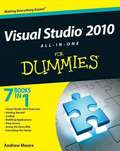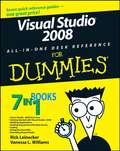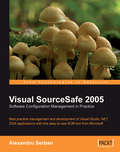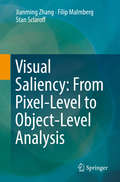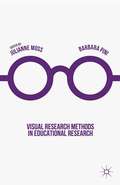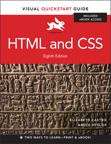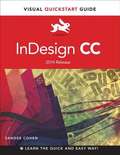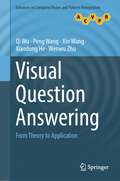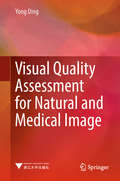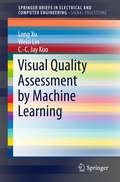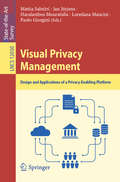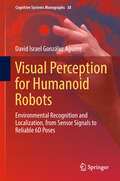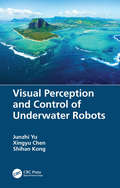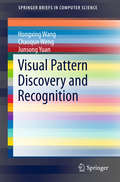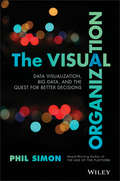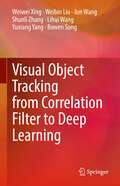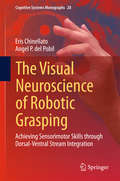- Table View
- List View
Visual Studio 2019 Tricks and Techniques: A developer's guide to writing better code and maximizing productivity
by Paul Schroeder Aaron Cure Ed PriceHarness the full power of the Visual Studio IDE to take your coding skills to the next level by learning about IDE productivity practices and exclusive techniquesKey FeaturesIncrease your productivity by leveraging Visual Studio 2019's improvements and featuresExplore powerful editing, code intelligence, and source code control features to increase productivityDelve into VS's powerful, untapped features such as custom project templates and extensionsBook DescriptionVisual Studio 2019 (VS 2019) and Visual Studio Code (VS Code) are powerful professional development tools that help you to develop applications for any platform with ease. Whether you want to create web, mobile, or desktop applications, Microsoft Visual Studio is your one-stop solution. This book demonstrates some of the most sophisticated capabilities of the tooling and shows you how to use the integrated development environment (IDE) more efficiently to be more productive. You'll begin by gradually building on concepts, starting with the basics. The introductory chapters cover shortcuts, snippets, and numerous optimization tricks, along with debugging techniques, source control integration, and other important IDE features that will help you make your time more productive. With that groundwork in place, more advanced concepts such as the inner workings of project and item templates are covered. You will also learn how to write quality, secure code more efficiently as well as discover how certain Visual Studio features work 'under the hood'. By the end of this Visual Studio book, you'll have learned how to write more secure code faster than ever using your knowledge of the extensions and processes that make developing successful solutions more enjoyable and repeatable.What you will learnUnderstand the similarities and differences between VS 2019 and VS CodeGet to grips with numerous keyboard shortcuts to improve efficiencyDiscover IDE tips and tricks that make it easier to write codeExperiment with code snippets that make it easier to write repeating code patternsFind out how to customize project and item templates with the help of hands-on exercisesUse Visual Studio extensions for ease and improved productivityDelve into Visual Studio's behind the scene operationsWho this book is forThis book is for C# and .NET developers who want to become more efficient and take advantage of features they may not be aware of in the IDE. Those looking to increase their productivity and write quality code more quickly by fully utilizing the power of the Visual Studio IDE will also find this book useful.
Visual Studio 2015 Cookbook - Second Edition
by Jeff MartinOver 50 new and improved recipes to put Visual Studio 2015 to work in your crucial development projects About This Book * Get to grips with all the new Visual Studio 2015 features regardless of your preferred programming language * Apply Visual Studio to all areas of development: writing, debugging, and application lifecycle maintenance * Straightforward and hands-on advice for building both Windows and Android apps Who This Book Is For If you are a developer excited about the new features introduced in Visual Studio 2015, then no matter what your programming language of choice is, Visual Studio 2015 Cookbook is for you. You should have a good knowledge of working with previous versions of Visual Studio to benefit from the recipes in this book. What You Will Learn * Customize the editor's new abilities to fit your development style * Create apps for Windows * Use Visual Studio to debug parallel and concurrent programs * Integrate .NET Framework 4.6 effectively * Put TypeScript to work in your web applications * Develop modern C++11 with Visual Studio 2015 * Protect and manage your source code with Team Foundation Server In Detail Visual Studio 2015 is the premier tool for developers targeting the Microsoft platform. Learning how to effectively use this technology can enhance your productivity while simplifying your most common tasks, allowing you more time to focus on your project. Visual Studio 2015 is packed with improvements that increase productivity, and this book walks you through each one in succession to help you smooth your workflow and get more accomplished. From customization and the interface to code snippets and debugging, the Visual Studio upgrade expands your options -- and this book is your fast-track guide to getting on board quickly. Visual Studio 2015 Cookbook will introduce you to all the new areas of Visual Studio and how they can quickly be put to use to improve your everyday development tasks. With this book, you will learn not only what VS2015 offers, but what it takes to put it to work for your projects. Style and approach This book is a practical guide to using Visual Studio 2015 and will help you become familiar with the improvements made in previous versions. Each recipe provides a hands-on approach to the new features with step-by-step instructions on how to increase your productivity.
Visual Studio 2013 Cookbook
by Richard Banks Jeff MartinThis book is a practical guide to using Visual Studio 2013 that will help you become familiar with the improvements made over previous versions. Each recipe provides a hands-on approach to the new features with step-by-step instructions on how to increase your productivity. If you are a developer excited about the new features introduced in Visual Studio 2013, then no matter what your programming language of choice is, Visual Studio 2013 Cookbook is for you. You should have a good knowledge of working with previous versions of Visual Studio to enjoy the recipes in this book. This book provides practical examples to help you use Visual Studio 2013 more effectively.
Visual Studio 2013 and .NET 4.5 Expert Cookbook
by Abhishek SurIf you are a Visual Studio 2013 or .NET developer who would like to sharpen your existing skill set and adapt to new .NET technologies, this is the book for you. A basic understanding of .NET and C# is required.
Visual Studio 2012 Cookbook
by Richard Banks"Visual Studio 2012 Cookbook" is a concise and practical cookbook with recipes which get you up and running straight away with all the new functionality of Visual Studio 2012. If you are a developer excited about the new features introduced in Visual Studio 2012, then no matter what your programming language of choice is, "Visual Studio 2012 Cookbook" is for you. You should have a good knowledge of working with previous versions of Visual Studio to enjoy the recipes in this book.
Visual Studio 2012 and .NET 4.5 Expert Development Cookbook
by Abhishek SurThis book is written in a cookbook-style format and provides practical, immediately usable task-based recipes that provide solutions to common development problems and help you adapt to the latest .NET technologies.This book is aimed at Visual Studio 2012 and .Net developers who want to gain advanced understanding and sharpen their existing skillsets and adapt to new .NET technologies. Basic understanding of .NET and C# is assumed. The purpose of this book is to give under the hood expertise in .NET and help you to face common problems on latest technologies.
Visual Studio 2010 Best Practices
by Peter RitchieIt will be a step-by-step tutorial that will discuss best practices. The book is structured in such a way that it can be read both from start to end or can dipped into. .Net developers using Visual Studio for programming will find this book useful. If you are developing your application with C#, you will find better ways to do things with Visual Studio. You should know basics of development with .Net Framework and need working knowledge on VIsual Studio
Visual Studio® 2010 and .NET 4
by István Novák András Velvárt Adam Granicz György Balássy Attila Hajdrik Mitchel Sellers Gastón C. Hillar Ágnes Molnár Joydip KanjilalComplete coverage of all key . NET 4 and Visual Studio 2010 languages and technologies . NET 4 is Microsoft's latest version of their core programming platform, and Visual Studio 2010 is the toolset that helps write . NET 4 applications. This comprehensive resource offers one-stop shopping for all you need to know to get productive with . NET 4. Experienced author and . NET guru Mitchel Sellers reviews all the important new features of . NET 4, including . NET charting and ASP. NET charting, ASP. NET dynamic data and jQuery, and the addition of F# as a supported package language. The expansive coverage is divided into six distinctive parts for easy navigation, and addresses: Visual Studio 2010, . NET 4, ASP. NET, the C# language, the VB. NET language, and the new F# language. A practical approach and complete examples round out this much-needed reference. Focuses on the new and important features of the latest version Microsoft's core programming platform-. NET 4-as well as Visual Studio 2010, which allows you to write . NET 4 applications Provides comprehensive coverage divided into six parts: Visual Studio 2010, . NET 4, ASP. NET, the C# language, the VB. NET language, and the new F# language Discusses Visual Studio snippets and templates, . NET charting components, the . NET framework and WPF, LINQ, and the Entity framework Explores various aspects of Visual Basic 2010, such as multi-line lambdas, auto-implemented properties, nullable optional parameters, and more This investigative look at . NET 4 and Visual Studio 2010 will help you identify and isolate key elements that can benefit you immediately.
Visual Studio 2010 All-in-One For Dummies
by Andrew MooreA comprehensive, easy-to-understand guide to Visual Studio 2010Visual Studio is Microsoft's comprehensive development environment that encompasses the .NET Framework, various programming languages, and ASP.NET. Programmers love it for developing applications for mobile devices and the Web.Because Visual Studio can be complex, the All-in-One For Dummies format makes it easy for beginners to grasp its different parts and get up to speed.Visual Studio is a development environment used with various programming languages to create a variety of applications, including those for the Web and mobile devicesThe updated Visual Studio 2010 features new emphasis on development for Windows 7, cloud computing, and enhanced Web and SilverlightVisual Studio 2010 All-in-One For Dummies shows how to build applications using the enhanced productivity features of Visual Studio 2010Minibooks cover a Visual Studio overview, getting started, building Windows 7 and cloud applications, data access, coding, and other IDE detailsIdeal for new programmers or Java programmers who want to become proficient with Visual StudioVisual Studio 2010 All-in-One For Dummies provides both a great instruction book for new programmers and a valuable reference for the more experienced.
Visual Studio 2008 All-In-One Desk Reference For Dummies
by Vanessa L. Williams Rick LeineckerVisual Studio 2008 is packed with features that help you create better software and do it with less repetition and drudgery. Visual Studio 2008 All-In-One Desk Reference For Dummies shows you how to make the most of this cool suite of tools! It's all here!This comprehensive, seven-books-in-one guide gets you up and running with Visual Studio 2008 in no time. You'll discover Microsoft's vision for Visual Studio, get familiar with the .Net environment and languages, and learn how to install, browse, and make connections with Visual Studio. Soon, you'll be building applications for Vista, Office 2007, and mobile devices; using AJAX and LINQ; and testing and debugging your programs. Discover how to:Understand Visual Studio's role in software developmentWork with .Net languagesDevelop applications for VistaBuild smart client interfacesUse the visual data designerUse Ajax controlsStreamline application deploymentDebug your applicationsExplore ASP. NET servicesWork with strongly typed data setsAccess data with Visual StudioProgram with Visual Studio 2008Build professional reports with Crystal ReportsFully updated with new information on Vista and .NET Framework 3.0 development, MS Office application development, and more, Visual Studio 2008 All-In-One Desk Reference For Dummies also features a companion Web site packed with sample projects, supplemental podcasts, and a support forum. You'll never find a smarter way to get up to speed with Visual Studio 2008!
Visual SourceSafe 2005 Software Configuration Management in Practice
by Aleksandar SeovicAfter introducing the fundamental principles of SCM and the benefits of using SCM to manage the software development lifecycle this book uses a real-world case-study project to build a Service-Oriented Application named Orbital Hotel. You will learn the team cooperation features in Visual SourceSafe with the help of John and Mary, two fictional team members assigned to implement various project components. You can visit Orbital Hotel online and you can download its source code. The appendices deal with SourceSafe administration tasks: database creation and management, how to secure the database and how to assign users and user rights, how to manage projects and project settings, and how to customize SourceSafe to best suit your development style. This book is for .NET developers, testers and configuration managers who: Use Visual Studio .NET 2005 for building software Want to use software configuration to manage their products in day-to-day activities Want to improve their efficiency by learning to use the best practices with SourceSafe Want to install, manage, and configure Visual SourceSafe 2005 for optimal operation The book does not assume previous knowledge of Software Configuration Management or Visual SourceSafe. It takes the reader from the ground up and is a great resource for people starting to learn about this subject. Readers with previous SourceSafe experience will benefit by discovering the improved and new features in Visual SourceSafe 2005.
Visual Saliency: From Pixel-Level to Object-Level Analysis
by Jianming Zhang Filip Malmberg Stan SclaroffThis book will provide an introduction to recent advances in theory, algorithms and application of Boolean map distance for image processing. Applications include modeling what humans find salient or prominent in an image, and then using this for guiding smart image cropping, selective image filtering, image segmentation, image matting, etc. In this book, the authors present methods for both traditional and emerging saliency computation tasks, ranging from classical low-level tasks like pixel-level saliency detection to object-level tasks such as subitizing and salient object detection. For low-level tasks, the authors focus on pixel-level image processing approaches based on efficient distance transform. For object-level tasks, the authors propose data-driven methods using deep convolutional neural networks. The book includes both empirical and theoretical studies, together with implementation details of the proposed methods. Below are the key features for different types of readers.
Visual Research Methods in Educational Research
by Julianne Moss Barbara PiniHave you noticed there is a burgeoning take up of visual research in education? Are you considering using visual research as part of your next research project or revitalising your research methods course? For researchers who are new to the field of VRMs in education there is little critical literature on the subject. This book addresses the gap in the literature and brings together some of the leading educational researchers engaging and reflecting on the visual from Australia, the UK and Canada. Encapsulated in a single volume, this book sets out theoretically grounded discussions of the possibilities and challenges of the approach for educational researchers around four key themes: images of schooling, performing pedagogy, power and representation and ethical issues in educational research.
Visual Quickstart Guide: HTML and CSS
by Elizabeth Castro Bruce HyslopNeed to learn HTML and CSS fast? This best-selling reference's step-by-step, task-based instructions will have you up and running with HTML in no time. In this updated edition author Bruce Hyslop uses crystal-clear instructions and friendly prose to introduce you to all of today's HTML and CSS essentials. The book has been refreshed to feature current web design best practices. You'll learn how to design, structure, and format your website. You'll learn about the new elements and form input types in HTML5. You'll create and use images, links, styles, and forms; and you'll add video, audio, and other multimedia to your site. You'll learn how to add visual effects with CSS3. You'll understand web standards and learn from code examples that reflect today's best practices. Finally, you will test and debug your site, and publish it to the web. Throughout the book, the author covers all of HTML and offers essential coverage of HTML5 and CSS techniques.
Visual Quickstart Guide: Indesign CC (2014 Release for Windows and MacIntosh)
by Sandee CohenInDesign CC: Visual QuickStart Guide (2014 release) is your complete guide to the core functions of InDesign as well as all the important new features. New to this edition is coverage of the greatly expanded ebook export capabilities, including Fixed Layout EPUB. With the growth in digital publishing, these new functions will empower designers to create more compelling digital documents than ever before. Other landmark new features in the 2014 release of InDesign CC include: the ability to reformat tables by dragging and dropping; integration with the hot portfolio site, Behance, and improvements to footnotes. Using the task-based, visual approach that is the trademark of the Visual QuickStart Guides readers will learn not only how to create documents, but also to use automation to streamline the process, as well as importing and styling text and objects, managing long documents, exporting files for a wide variety of purposes, and much more.
Visual Question Answering: From Theory to Application (Advances in Computer Vision and Pattern Recognition)
by Qi Wu Peng Wang Xin Wang Xiaodong He Wenwu ZhuVisual Question Answering (VQA) usually combines visual inputs like image and video with a natural language question concerning the input and generates a natural language answer as the output. This is by nature a multi-disciplinary research problem, involving computer vision (CV), natural language processing (NLP), knowledge representation and reasoning (KR), etc. Further, VQA is an ambitious undertaking, as it must overcome the challenges of general image understanding and the question-answering task, as well as the difficulties entailed by using large-scale databases with mixed-quality inputs. However, with the advent of deep learning (DL) and driven by the existence of advanced techniques in both CV and NLP and the availability of relevant large-scale datasets, we have recently seen enormous strides in VQA, with more systems and promising results emerging. This book provides a comprehensive overview of VQA, covering fundamental theories, models, datasets, and promising future directions. Given its scope, it can be used as a textbook on computer vision and natural language processing, especially for researchers and students in the area of visual question answering. It also highlights the key models used in VQA.
Visual Quality Assessment for Natural and Medical Image
by Yong DingImage quality assessment (IQA) is an essential technique in the design of modern, large-scale image and video processing systems. This book introduces and discusses in detail topics related to IQA, including the basic principles of subjective and objective experiments, biological evidence for image quality perception, and recent research developments. In line with recent trends in imaging techniques and to explain the application-specific utilization, it particularly focuses on IQA for stereoscopic (3D) images and medical images, rather than on planar (2D) natural images. In addition, a wealth of vivid, specific figures and formulas help readers deepen their understanding of fundamental and new applications for image quality assessment technology. This book is suitable for researchers, clinicians and engineers as well as students working in related disciplines, including imaging, displaying, image processing, and storage and transmission. By reviewing and presenting the latest advances, and new trends and challenges in the field, it benefits researchers and industrial R&D engineers seeking to implement image quality assessment systems for specific applications or design/optimize image/video processing algorithms.
Visual Quality Assessment by Machine Learning
by Long Xu Weisi Lin C.-C. Jay KuoThe book encompasses the state-of-the-art visual quality assessment (VQA) and learning based visual quality assessment (LB-VQA) by providing a comprehensive overview of the existing relevant methods. It delivers the readers the basic knowledge, systematic overview and new development of VQA. It also encompasses the preliminary knowledge of Machine Learning (ML) to VQA tasks and newly developed ML techniques for the purpose. Hence, firstly, it is particularly helpful to the beginner-readers (including research students) to enter into VQA field in general and LB-VQA one in particular. Secondly, new development in VQA and LB-VQA particularly are detailed in this book, which will give peer researchers and engineers new insights in VQA.
Visual Privacy Management: Design and Applications of a Privacy-Enabling Platform (Lecture Notes in Computer Science #12030)
by Haralambos Mouratidis Paolo Giorgini Mattia Salnitri Jan Jürgens Loredana ManciniPrivacy is a burden for most organizations, the more complex and wider an organization is, the harder to manage and enforce privacy is.GDPR and other regulations on privacy impose strict constraints that must be coherently enforced, considering also privacy needs of organization and their users. Furthermore, organizations should allow their users to express their privacy needs easily, even when the process that manages users' data is complex and involves multiple organizations.Many research work consider the problem using simplistic examples, with solutions proposed that never actually touch pragmatic problems of real, large organizations, with thousands of users and terabytes of personal and sensitive data.This book faces the privacy management problem targeting actual large organizations, such as public administrations, including stakeholders in the process of definition of the solution and evaluating the results with its actual integration in four large organizations. The contribution of this book is twofold: a privacy platform that can be customized and used to manage privacy in large organizations; and the process for the design of such a platform, from a state-of-the-art survey on privacy regulations, through the definition of its requirements, its design and its architecture, until the evaluation of the platform.
Visual Perception for Humanoid Robots: Environmental Recognition and Localization, from Sensor Signals to Reliable 6D Poses (Cognitive Systems Monographs #38)
by David Israel González AguirreThis book provides an overview of model-based environmental visual perception for humanoid robots. The visual perception of a humanoid robot creates a bidirectional bridge connecting sensor signals with internal representations of environmental objects. The objective of such perception systems is to answer two fundamental questions: What & where is it? To answer these questions using a sensor-to-representation bridge, coordinated processes are conducted to extract and exploit cues matching robot’s mental representations to physical entities. These include sensor & actuator modeling, calibration, filtering, and feature extraction for state estimation. This book discusses the following topics in depth: • Active Sensing: Robust probabilistic methods for optimal, high dynamic range image acquisition are suitable for use with inexpensive cameras. This enables ideal sensing in arbitrary environmental conditions encountered in human-centric spaces. The book quantitatively shows the importance of equipping robots with dependable visual sensing. • Feature Extraction & Recognition: Parameter-free, edge extraction methods based on structural graphs enable the representation of geometric primitives effectively and efficiently. This is done by eccentricity segmentation providing excellent recognition even on noisy & low-resolution images. Stereoscopic vision, Euclidean metric and graph-shape descriptors are shown to be powerful mechanisms for difficult recognition tasks. • Global Self-Localization & Depth Uncertainty Learning: Simultaneous feature matching for global localization and 6D self-pose estimation are addressed by a novel geometric and probabilistic concept using intersection of Gaussian spheres. The path from intuition to the closed-form optimal solution determining the robot location is described, including a supervised learning method for uncertainty depth modeling based on extensive ground-truth training data from a motion capture system.The methods and experiments are presented in self-contained chapters with comparisons and the state of the art. The algorithms were implemented and empirically evaluated on two humanoid robots: ARMAR III-A & B. The excellent robustness, performance and derived results received an award at the IEEE conference on humanoid robots and the contributions have been utilized for numerous visual manipulation tasks with demonstration at distinguished venues such as ICRA, CeBIT, IAS, and Automatica.
Visual Perception and Control of Underwater Robots
by Junzhi Yu Xingyu Chen Shihan KongVisual Perception and Control of Underwater Robots covers theories and applications from aquatic visual perception and underwater robotics. Within the framework of visual perception for underwater operations, image restoration, binocular measurement, and object detection are addressed. More specifically, the book includes adversarial critic learning for visual restoration, NSGA-II-based calibration for binocular measurement, prior knowledge refinement for object detection, analysis of temporal detection performance, as well as the effect of the aquatic data domain on object detection. With the aid of visual perception technologies, two up-to-date underwater robot systems are demonstrated. The first system focuses on underwater robotic operation for the task of object collection in the sea. The second is an untethered biomimetic robotic fish with a camera stabilizer, its control methods based on visual tracking. The authors provide a self-contained and comprehensive guide to understand underwater visual perception and control. Bridging the gap between theory and practice in underwater vision, the book features implementable algorithms, numerical examples, and tests, where codes are publicly available. Additionally, the mainstream technologies covered in the book include deep learning, adversarial learning, evolutionary computation, robust control, and underwater bionics. Researchers, senior undergraduate and graduate students, and engineers dealing with underwater visual perception and control will benefit from this work.
Visual Pattern Discovery and Recognition
by Hongxing Wang Chaoqun Weng Junsong YuanThis book presents a systematic study of visual pattern discovery, from unsupervised to semi-supervised manner approaches, and from dealing with a single feature to multiple types of features. Furthermore, it discusses the potential applications of discovering visual patterns for visual data analytics, including visual search, object and scene recognition. It is intended as a reference book for advanced undergraduates or postgraduate students who are interested in visual data analytics, enabling them to quickly access the research world and acquire a systematic methodology rather than a few isolated techniques to analyze visual data with large variations. It is also inspiring for researchers working in computer vision and pattern recognition fields. Basic knowledge of linear algebra, computer vision and pattern recognition would be helpful to readers.
The Visual Organization
by Phil SimonThe era of Big Data as arrived, and most organizations are woefully unprepared. Slowly, many are discovering that stalwarts like Excel spreadsheets, KPIs, standard reports, and even traditional business intelligence tools aren't sufficient. These old standbys can't begin to handle today's increasing streams, volumes, and types of data. Amidst all of the chaos, though, a new type of organization is emerging. In The Visual Organization, award-winning author and technology expert Phil Simon looks at how an increasingly number of organizations are embracing new dataviz tools and, more important, a new mind-set based upon data discovery and exploration. Simon adroitly shows how Amazon, Apple, Facebook, Google, Twitter, and other tech heavyweights use powerful data visualization tools to garner fascinating insights into their businesses. But make no mistake: these companies are hardly alone. Organizations of all types, industries, sizes are representing their data in new and amazing ways. As a result, they are asking better questions and making better business decisions.Rife with real-world examples and case studies, The Visual Organization is a full-color tour-de-force.
Visual Object Tracking from Correlation Filter to Deep Learning
by Weiwei Xing Weibin Liu Jun Wang Shunli Zhang Lihui Wang Yuxiang Yang Bowen SongThe book focuses on visual object tracking systems and approaches based on correlation filter and deep learning. Both foundations and implementations have been addressed. The algorithm, system design and performance evaluation have been explored for three kinds of tracking methods including correlation filter based methods, correlation filter with deep feature based methods, and deep learning based methods. Firstly, context aware and multi-scale strategy are presented in correlation filter based trackers; then, long-short term correlation filter, context aware correlation filter and auxiliary relocation in SiamFC framework are proposed for combining correlation filter and deep learning in visual object tracking; finally, improvements in deep learning based trackers including Siamese network, GAN and reinforcement learning are designed. The goal of this book is to bring, in a timely fashion, the latest advances and developments in visual object tracking, especially correlation filter and deep learning based methods, which is particularly suited for readers who are interested in the research and technology innovation in visual object tracking and related fields.
The Visual Neuroscience of Robotic Grasping
by Eris Chinellato Angel P. PobilThis book presents interdisciplinary research that pursues the mutual enrichment of neuroscience and robotics. Building on experimental work, and on the wealth of literature regarding the two cortical pathways of visual processing - the dorsal and ventral streams - we define and implement, computationally and on a real robot, a functional model of the brain areas involved in vision-based grasping actions. Grasping in robotics is largely an unsolved problem, and we show how the bio-inspired approach is successful in dealing with some fundamental issues of the task. Our robotic system can safely perform grasping actions on different unmodeled objects, denoting especially reliable visual and visuomotor skills. The computational model and the robotic experiments help in validating theories on the mechanisms employed by the brain areas more directly involved in grasping actions. This book offers new insights and research hypotheses regarding such mechanisms, especially for what concerns the interaction between the dorsal and ventral streams. Moreover, it helps in establishing a common research framework for neuroscientists and roboticists regarding research on brain functions.
